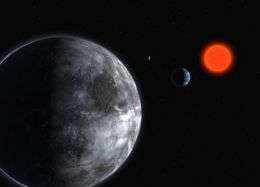Researchers Say Tides Can Cut Life Short On Planets Orbiting Smaller Stars

(PhysOrg.com) -- Planet hunters searching for planets suitable for life will likely find them first around low-mass stars because it's technically easier than finding such planets around hotter, more massive stars, researchers predict.
But Earth-like planets around stars smaller than our sun won't be liveable for long, according to a study led by Rory Barnes, a research associate with The University of Arizona's Lunar and Planetary Laboratory. Such planets can face "tidal extinction" within about a billion years.
A star only a quarter-to-a-tenth as massive as our sun is also cooler than our sun, so the "habitable zone" for its planets – where water is liquid – also will be closer in, Barnes said.
"This close proximity results in accelerated tidal evolution," Barnes said. "Tides will be so powerful that the Earth-like planet's orbit will shrink. In some cases, orbits can shrink so much and so quickly that the planet may pulled through the inner edge of the habitable zone in less than a billion years, and all the planet's water will boil away."
If habitable planets around low-mass stars are massive enough and, say, have more circular, less eccentric orbits, they could last 4.5 billion years – the age of the Earth – before the star's tidal forces tugs them closer in to roast.
"Planet hunters may detect planets in habitable zones that are doomed to become uninhabitable in the future," Barnes said. "Alternatively, they may find planets today that were liveable in the past, but where any life was wiped out by this process of tidal extinction."
Barnes, Brian Jackson and Professor Richard Greenberg, all with the UA Lunar and Planetary Laboratory, and Sean Raymond of the Center for Astrophysics and Space Astronomy at the University of Colorado, published their study in the article "Tides and the Evolution of Planetary Habitability," in Astrobiology magazine earlier this year.
Jackson, Barnes and Greenberg recently published another paper on the major role tidal forces play in pulling planets into and out of solar system habitable zones. One conclusion in that paper, published in the Monthly Notices of the Royal Astronomical Society, is that the first Earth-like planets found will likely be strongly heated and very volcanically active.
Barnes will talk about it at a departmental colloquium on Tuesday, Dec. 2.
Provided by University of Arizona




















